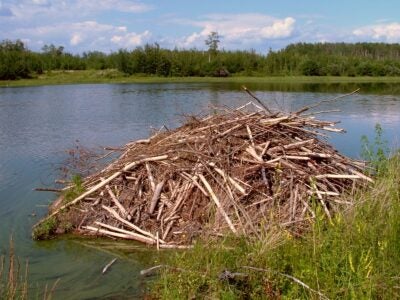Why do amazing beavers build dams?
Published 11:40 am Friday, December 22, 2023
|
Getting your Trinity Audio player ready...
|
Ever wonder why beavers build dams? I know, it’s not something you think about every day. But when you do…
Let’s start at the beginning. What exactly is a beaver?
As North America’s largest rodents, they have bright orange teeth, webbed feet and long flat tails. Why orange teeth, bright orange like pumpkins? It’s the iron in their teeth that makes them strong enough to gnaw through trees.
Living on ponds or streams, their flat tails help them swim but also can be slapped against the water’s surface to indicate danger is approaching. Reminding us of mini-submarines, they can stay underwater for up to 15 minutes. Compare that to us humans who can only hold our breath for about two minutes.
One of the things we love about this misunderstood mammal is they want to protect their families just like we do. Mating for life, they are fiercely loyal to their mates and young.
Often called ecological engineers, they are one of the few animals to manipulate their environment to survive. By cutting down trees using their incredibly strong (and remember very orange) teeth, they change the landscape. Then by damming up a stream, they manipulate the water to suit their needs. Pretty smart!
Because they are slow-moving on land, but excellent swimmers, they build their houses, called lodges, in the water. First, they drop trees growing along a stream into the water, slowing the stream down.
And this is one reason some folks don’t like beavers. Losing your favorite tree to a beaver can be quite upsetting. But put yourself in the beaver’s place and now you know they are only trying to care for their family.
Then they gather branches, sticks, rocks and mud in their mouths and swim out to the felled trees. Using their front paws, they construct a dam that stops the stream from flowing and creates a pond or wetlands behind the dam.
With the water slowed down, they can build their lodge and not fear it will wash away. Predators, like bears, coyotes and us humans, can’t get to the beaver family since their lodges have underwater entrances. How clever!
The wetlands provide habitat and food for lots of animals including frogs, birds, fish and all sorts of critters. It’s estimated that 70% of our endangered species in North Carolina depend on wetlands to survive. Wow, so without wetlands, we might lose some of our endangered plants and animals!
These wetlands also help clean the water. As the water slowly moves through the wetland, it leaves dirt and other pollutants behind, which means cleaner rivers and streams.
Wetlands also store carbon dioxide, a harmful greenhouse gas. Bottom line, wetlands help wildlife and help moderate climate conditions. And beavers create wetlands so now we get the connection!
But beavers need our help. Despite their importance in creating wetlands, beavers face challenges. Sometimes, people see them as a nuisance because their dams can flood roads or farmland. Also, beavers are still trapped for their fur, leading to a significant decrease in their population.
Now that we understand how beavers positively affect the environment, how can we co-exist with them? A few things can be done to mitigate damage to your property if they have taken up residence.
First, you can install wire mesh fences around trees, preventing them from being cut down by enterprising beavers. Second, beaver baffles can be installed allowing some water to pass through the dam without hurting the wetlands behind the dam. This can help alleviate flooding. For all the good they do, we need to find ways to live with them.
So help us spread the word about our amazing beavers. They build dams, protect their families, and help create wetlands. And they are some of the smartest, hardest-working animals we know. They are one of our true animal heroes, with great superpowers!

Loti Woods is a founder of Champions for Wildlife, a nonprofit organization whose mission is to inspire and empower the next generation to be champions for wildlife using art and education. To learn more, visit championsforwildlife.org or reach out to loti@championsforwildlife.org.


